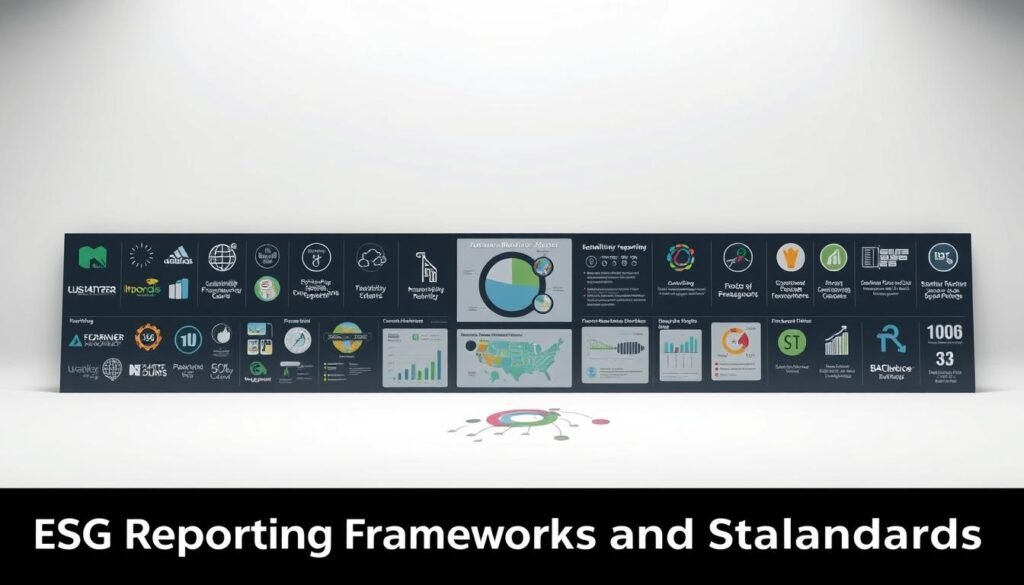Many organizations now see comprehensive disclosure not as a regulatory chore but as a powerful tool for business growth. This shift represents a fundamental change in how companies approach their responsibilities.
Forward-thinking businesses have moved beyond simple sustainability efforts. They now embed these principles into every aspect of their operations, from product development to daily practices.
This transformation allows companies to demonstrate genuine commitment to stakeholders while attracting investment. The focus has shifted from mere compliance to creating meaningful impact.
Effective disclosure requires understanding both regulatory requirements and strategic opportunities. Organizations that master this balance gain significant advantages in today’s transparent business environment.
Key Takeaways
- Comprehensive disclosure has evolved from compliance to strategic advantage
- Companies now integrate sustainability throughout their operations and strategy
- Transparent practices attract investors and build stakeholder trust
- Effective approaches balance regulatory requirements with business opportunities
- Organizations demonstrating genuine commitment gain competitive edge
- Proper implementation requires understanding frameworks and metrics
- Strategic disclosure can drive both ethical responsibility and financial benefits
Understanding ESG Reporting: An Introduction
The 2004 UN report ‘Who Cares Wins’ marked a turning point in investment analysis methodologies. This groundbreaking document first integrated environmental, social and governance factors into financial evaluation processes.
What is ESG Reporting?
This systematic disclosure process shares environmental, social and governance performance data with stakeholders. It includes both qualitative narratives and quantitative metrics that demonstrate a company’s sustainability performance.
Investors use these comprehensive reports to screen potential investments and align them with their values. The data helps avoid companies with significant environmental or social risks while identifying organizations with strong practices.
The Evolution from Sustainability to ESG
Traditional sustainability efforts focused primarily on environmental impacts and resource management. The ESG framework expands this scope to include social responsibility and governance considerations.
While sustainability guides internal capital investment decisions, ESG serves as an external communication tool. This evolution reflects growing investor demand for comprehensive transparency across all business operations.
Companies now view robust disclosure as essential for attracting financing and demonstrating long-term viability. The transition from voluntary initiatives to structured frameworks continues to shape modern business practices.
ESG vs. Sustainability vs. CSR: Key Differences
Corporate responsibility efforts often get confused under similar-sounding terms. Understanding their distinct purposes helps clarify why each approach matters in modern business.
Sustainability and corporate social responsibility represent the motivation behind ethical business practices. They drive companies to act in society’s best interests through conscious operations.
Motivation vs. Outcomes: How ESG Differs
Corporate social responsibility operates as a voluntary business model. Companies choose activities that enhance their communities and environment beyond regular operations.
Patagonia exemplifies strong CSR through its repair services and anti-fast fashion advocacy. The outdoor brand uses sustainable materials and promotes conscious consumption.
CSR typically focuses on philanthropic activities and ethical practices. It includes charitable donations, volunteer programs, and community outreach initiatives.
Environmental, social, and governance frameworks provide measurable outcomes rather than motivations. They deliver concrete data for stakeholder decision-making and risk assessment.
This data-driven approach integrates values directly into core business operations. It moves beyond charitable efforts to demonstrate operational integration of sustainability principles.
Why Investors Prefer ESG Over CSR
Investment professionals seek quantifiable information for screening opportunities. Philanthropic intentions don’t provide the measurable insights needed for risk evaluation.
ESG metrics offer standardized performance indicators across environmental and social areas. Investors can compare companies using consistent data points and evaluation methods.
This preference drives the shift from voluntary CSR to increasingly mandatory disclosure. Regulatory requirements and investor demands accelerate this transition across industries.
Measurable outcomes provide greater accountability than qualitative philanthropic efforts. They demonstrate how companies manage emissions, human rights, and governance practices.
The trend toward transparency and investor appeal continues growing. Organizations adopting robust frameworks gain competitive advantages in attracting capital and talent.
The Current State of ESG Reporting in the United States
American companies navigate a complex landscape of disclosure requirements. Unlike European mandates, U.S. regulations create a patchwork approach to transparency.
This environment reflects a transition from voluntary initiatives to structured expectations. Organizations must balance multiple frameworks while meeting stakeholder demands.
Regulatory Landscape and Compliance Requirements
The SEC primarily focuses on material information disclosure. This approach differs significantly from comprehensive European mandates.
California leads state-level initiatives with groundbreaking climate legislation. The Climate Corporate Data Accountability Act affects companies with revenues exceeding $1 billion.
These organizations must report greenhouse gas emissions starting in 2026. The Climate-Related Financial Risk Act covers businesses with $500 million in revenue.
This legislation requires detailed climate risk disclosures for California operations. Both laws represent significant steps toward increased corporate transparency.
Trends Shaping ESG Disclosure Practices
Global adoption continues growing rapidly among major corporations. Eighty percent of N100 firms now publish sustainability reports.
This widespread adoption indicates shifting business priorities worldwide. Companies seek comparability through standardized frameworks.
Generational investment preferences drive future demand for transparent practices. Morgan Stanley’s research shows 86% of Millennials interest in sustainable investing.
Seventy-two percent of Generation Z believes responsible investing improves outcomes. These preferences create increasing investor pressure for comprehensive disclosure.
Organizations face growing expectations despite varying regulatory requirements. The current environment reflects this important transition period.
Components of ESG: Environmental, Social, and Governance
Effective corporate transparency relies on three distinct yet interconnected components that address different stakeholder concerns. These pillars form the foundation of comprehensive disclosure practices that investors and communities increasingly demand.
Environmental Factors: Climate Change and Resource Management
Climate action represents a critical environmental priority for modern organizations. Companies implement strategies to reduce carbon emissions through energy efficiency and renewable energy adoption.
Resource management extends beyond emissions to include biodiversity preservation and ecosystem protection. Many businesses now track water usage and air quality impacts across their operations.
Waste reduction initiatives and circular economy principles guide responsible resource utilization. Supply chain transparency ensures materials sourcing aligns with environmental standards.
Deforestation prevention has become a key focus area for companies using forest products. These comprehensive environmental metrics provide valuable esg data for stakeholder evaluation.
Social Factors: Diversity, Inclusion, and Human Rights
Workplace diversity initiatives address gender equity, racial inclusion, and LGBTQ+ representation. These programs create more innovative and representative organizational cultures.
Human rights considerations extend throughout global operations and supply chains. Companies must ensure fair labor standards and safe working conditions across all locations.
Employee engagement strategies foster positive work environments and talent retention. Data protection protocols safeguard personal information while maintaining operational transparency.
Community involvement programs demonstrate corporate commitment beyond business boundaries. These social components reflect genuine social responsibility in daily operations.
Governance Factors: Ethics, Leadership, and Transparency
Internal controls establish ethical frameworks for decision-making and operations. Board composition requirements ensure diverse perspectives in leadership positions.
Executive compensation structures align with long-term performance and sustainability goals. Audit committee organization maintains financial integrity and compliance standards.
Shareholder rights protection mechanisms ensure fair treatment and voice for investors. Anti-corruption measures include bribery prevention and transparent lobbying practices.
Political contribution disclosures and whistleblower programs reinforce ethical standards. These governance elements create the foundation for trustworthy organizational leadership.
Together, these three components form a comprehensive framework that addresses full stakeholder concerns. The integration of environmental, social, and governance factors demonstrates holistic corporate responsibility.
ESG Scores, Ratings, and Regulatory Frameworks
Organizations rely on structured evaluation systems to measure their impact and compliance. These systems help investors and stakeholders assess company performance and risk.
How ESG Scores Are Calculated and by Whom
Third-party providers create these evaluations using different methods. Major firms include Bloomberg ESG Data Services and Sustainalytics ESG Risk Ratings.
The Dow Jones Sustainability Index Family and RepRisk also provide important ratings. Each organization uses unique criteria to calculate scores.
These evaluations function similarly to credit scores. They measure a company’s ability to meet commitments and manage risk.
Rating variability occurs because agencies use different methodologies. This creates diverse perspectives on organizational performance.
Third parties measure how environmental and social factors impact economic value. Their insights help investors make informed decisions.
Key Regulations: EU Directives and U.S. SEC Guidelines
The European Union maintains the most comprehensive regulatory framework. Their system includes the EU Taxonomy classification for sustainable activities.
The Sustainable Finance Disclosure Regulation requires 18 mandatory indicators. It took effect in March 2021 with optional additional disclosures.
The Corporate Sustainability Reporting Directive replaces the Non-Financial Reporting Directive. This revised version introduces tougher requirements for organizations.
United States guidelines focus on material information disclosure. The SEC works to prevent misconduct like greenwashing and fraud.
EU regulations are mandatory while the U.S. approach remains more discretionary. Global frameworks continue evolving toward greater standardization.
Regulatory requirements increasingly emphasize mandatory disclosure across markets. This shift reflects growing stakeholder demand for transparency.
ESG Reporting Frameworks and Standards
Companies today navigate multiple frameworks to communicate their sustainability journey effectively. These systems provide structured approaches for measuring and sharing organizational impact.
Organizations select standards that align with their industry needs and stakeholder expectations. The right framework helps present comprehensive esg data clearly.
Global Reporting Initiative (GRI) and SASB
The Global Reporting Initiative remains the most widely referenced system globally. Eighty-three percent of companies across industries use GRI standards for their disclosures.
This framework helps businesses disclose both positive and negative impacts on environment, economy, and society. It provides comprehensive metrics for complete transparency.
The Sustainability Accounting Standards Board offers industry-specific guidelines with financial impact focus. SASB standards help investors understand material sustainability factors affecting financial performance.
These two organizations joined forces in 2020 to create better alignment. They published a practical guide for using both standards together effectively.
This collaboration helps companies address different stakeholder needs through complementary approaches. Organizations can present both broad impact and financially material information.
Task Force on Climate-related Financial Disclosures (TCFD)
The TCFD provides principles-based recommendations for climate risk reporting. It focuses specifically on financial implications of climate-related issues.
This framework helps companies assess and disclose climate-related risks and opportunities. It emphasizes governance, strategy, risk management, and metrics targets.
Many organizations use TCFD recommendations to structure their climate disclosures. Investors value this consistent approach to climate risk assessment.
Other Notable Frameworks: CDP, SECR, and WDI
The Carbon Disclosure Project framework focuses on environmental data disclosure. It covers greenhouse gas emissions, water use, and forestry impacts.
CDP uses a questionnaire-based approach with scoring system. Companies receive ratings based on their environmental management and performance.
The Streamlined Energy and Carbon Reporting framework comes from the UK government. It mandates annual carbon emissions reporting for qualifying organizations.
The Workforce Disclosure Initiative represents an investor collective framework. It focuses on comprehensive workforce data disclosure and practices.
WDI helps investors compare companies on human capital management. It addresses diversity, working conditions, and employee relations metrics.
Frameworks generally fall into three categories based on their nature and requirements. Benchmark frameworks like CDP require responses and provide scores.
Voluntary frameworks including GRI and TCFD allow selective reporting approaches. Regulatory frameworks such as CSRD and SFDR represent government-mandated systems.
Most companies use multiple frameworks to address different stakeholder needs. This approach ensures comprehensive coverage of various disclosure requirements.
Organizations blend frameworks to create robust sustainability reporting practices. They select systems that best communicate their specific esg performance story.
Strategies for Effective ESG Disclosure
Successful corporate transparency requires more than good intentions. It demands systematic approaches that transform sustainability goals into measurable outcomes.
Organizations need clear roadmaps for collecting, managing, and presenting their performance data. These strategies ensure stakeholders receive accurate information that reflects genuine progress.
Implementing Robust Data Collection and Management
Comprehensive systems capture relevant metrics across all business areas. They gather information from supply chains, operations, and community initiatives.
Effective collection methods ensure consistent esg data quality. They track everything from carbon emissions to diversity metrics.
Companies must establish clear protocols for data verification. Audit trails document information sources and processing methods.
This approach supports compliance with regulatory requirements. It also builds stakeholder confidence through transparent practices.
Leveraging Technology for Streamlined Reporting
Modern platforms like Salesforce’s Net Zero Cloud transform sustainability management. They handle real-time esg data across disconnected systems.
Technology solutions automate report generation for various reporting frameworks. They track progress against goals and forecast future trends.
These platforms connect operational data with sustainability metrics. They provide valuable insights for strategic decision-making.
Automation reduces manual errors in the reporting process. It also saves time while improving data accuracy.
Ensuring Accuracy and Avoiding Greenwashing
Organizations must prioritize truthful representation of their esg performance. Exaggerated environmental claims damage credibility and trust.
The materiality assessment helps identify most relevant issues for each company. Risk matrix approaches prioritize areas with greatest business impact.
Double materiality considers both financial significance and societal effects. It examines how issues affect markets, environments, and people.
Action priority matrices highlight areas where companies can make rapid improvements. They focus efforts where organizations have direct influence.
Accurate sustainability reporting demonstrates real commitment beyond superficial claims. It builds lasting trust with investors and communities.
Proper verification processes ensure information reliability. They create foundations for meaningful transparency and continuous improvement.
Business Benefits of Comprehensive ESG Reporting
Companies embracing thorough sustainability disclosure unlock significant advantages beyond compliance. These organizations transform their operations while building stronger market positions.
Enhancing Transparency and Stakeholder Trust
Open communication builds lasting relationships with communities and customers. Clear disclosure demonstrates genuine commitment to ethical practices.
Most American consumers willingly pay more for sustainable products. This preference creates market advantages for transparent companies.
Strong esg performance improves brand perception and customer loyalty. Organizations gain competitive edges through honest communication.
Improving Financial Performance and Market Competitiveness
Operational efficiencies deliver substantial cost savings across organizations. Energy management and waste reduction directly impact profitability.
Seventy-six percent of CEOs would divest profitable units damaging reputation. This shows leadership commitment to long-term value creation.
Bain & Company research confirms higher productivity in companies with strong practices. Employee satisfaction improves through meaningful workplace initiatives.
Attracting Investors and Top Talent
Capital access increases significantly for organizations with robust disclosure. Seventy-one percent of investors demand risk integration into corporate strategy.
Eighty-two percent of global workers prefer employers with sustainability focus. Talent attraction and retention improve with demonstrated commitment.
Investments focusing on comprehensive metrics typically outperform alternatives. This performance advantage attracts patient capital and loyal stakeholders.
Thorough disclosure demonstrates effective risk management and long-term viability. Companies build foundations for sustained growth and market leadership.
Conclusion: The Future of ESG Reporting
Mandatory disclosure requirements will expand globally following the EU’s Corporate Sustainability Reporting Directive. This framework applies to organizations with over 250 employees, €50 million revenue, or €25 million in assets starting January 2025.
Artificial intelligence platforms will transform how companies manage environmental and social data. These tools automate collection processes and provide valuable performance insights.
Global standardization becomes inevitable as 80% of major firms already publish sustainability reports. Companies should begin tracking goals now rather than waiting for perfect systems.
Start with small, manageable initiatives and gradually expand comprehensive disclosure. View this process as a strategic advantage in transparent markets.
Effective transparency requires ongoing commitment and technological investment throughout organizations. It represents a business imperative rather than optional corporate responsibility.
FAQ
What is ESG reporting?
ESG reporting involves publicly sharing information about a company’s performance in environmental, social, and governance areas. It covers topics like carbon emissions, diversity efforts, and board transparency to give stakeholders a clear view of the organization’s impact and ethics.
How does ESG differ from CSR?
CSR focuses on a company’s voluntary initiatives to benefit society, often driven by philanthropy. ESG is more data-driven, emphasizing measurable performance metrics that investors use to assess risk, value, and long-term business resilience.
What are key ESG frameworks used today?
Widely adopted frameworks include the Global Reporting Initiative (GRI) for comprehensive disclosures, the Sustainability Accounting Standards Board (SASB) for industry-specific metrics, and the Task Force on Climate-related Financial Disclosures (TCFD) for climate risk reporting.
Why is ESG important to investors?
Investors rely on ESG data to evaluate a company’s management of risks like climate change, labor practices, and ethical leadership. Strong performance can signal better long-term stability, innovation, and returns, influencing investment decisions.
How can companies avoid greenwashing in their reports?
Companies should ensure data accuracy, use verified third-party audits, adhere to recognized standards like GRI or SASB, and provide transparent, comparable metrics. Avoiding exaggerated claims and focusing on genuine progress builds credibility.
What are the benefits of strong ESG disclosure?
Comprehensive disclosure boosts stakeholder trust, helps attract investment, improves risk management, and can enhance market competitiveness. It also supports talent acquisition by showcasing a commitment to ethical and sustainable practices.







